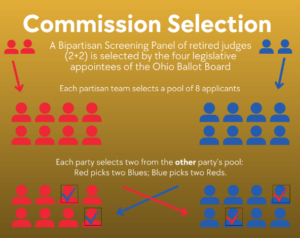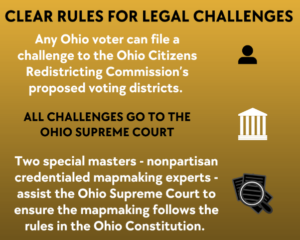Blog Post
Common Cause Ohio’s Coffee Hour Follow Up
Blog Post
On the November 2024 ballot, the Citizens Not Politicians amendment seeks to rectify not only Ohio’s gerrymandering problem, but is also designed to stop the judicial merry-go-round. With that, the legal process of mapmaking would look different.
Before any mapmaking begins, there is a selection process for both a citizen redistricting commission and a pool of “Special Masters”, credentialed experts to expedite legal challenges, with retired judges playing a role in executing each one.
The proposal would create the Ohio Citizens Redistricting Commission (“Commission”), a 15-member citizen panel of five Republicans, five Democrats and five Independents representing a geographic and demographic cross-section of the state. Members would be selected by a Bipartisan Screening Panel (“Panel”) made up of four Ohio retired judges—two affiliated with the First Major Political Party and two affiliated with the Second Major Political Party.
Retired judges who apply to be part of the Bipartisan Screening Panel would be required to complete a form that provides sufficient information to enable Ballot Board members to assess each judge’s qualifications and ability to be impartial and competent.

The four retired judges would be selected by the four legislative appointees of the Ohio Ballot Board: the biggest political party (in this case, the Republicans) selects a pool of eight candidates from which the second party (the Democrats) select two. Then the process is reversed. Democrats select a pool of eight candidates, and the Republicans pick two from that pool.
The selected judges then review the applications for commissioners, screening out politicians and lobbyists, and select 45 finalists, 15 from each pool (Republicans, Democrats, and Independents). From that group, the Panel randomly picks six commissioners (two from each pool) and then those six choose the final nine commission members.
The Panel is also responsible for the initial selection of “Special Masters” or cartographers to help assess the maps in the event of a legal challenge. The Panel will create a pool of at least six special masters who are willing to serve if necessary. Beyond having the knowledge and ability to analyze district maps, the candidates must not be associated with any political party.
If the Citizens Not Politicians amendment passes in November, the redistricting legal landscape would look much different than it currently does. The Ohio Supreme Court would still retain exclusive jurisdiction over challenges to the new voting districts, but adjudication would require an expedited review process.
Before the case is ever heard by the Ohio Supreme Court, two Special Masters are selected by the Court from the pool established by the Panel of retired judges to review the challenged district or districts and issue a report as to whether the commission failed to draw compliant maps.

Challenges to a redistricting plan or the proposed voting districts can be filed in the Ohio Supreme Court by any Ohio voter within 10 days of the Commission issuing its final report. Only the Commission will have the legal authority to respond to any challenges.
There are several possible outcomes:
If there are no objections to the report, then the Court would issue an order adopting the special masters’ report and determination. This is a final, non-reviewable decision.
If the Court finds that the Commission’s map was not compliant with the requirements in the Ohio Constitution, then the Commission has to make the necessary adjustments within seven days and give the revised proposal to the Court and Special Masters. If the Commission follows through on making the constitutionally prescribed adjustments, then the Supreme Court would issue an order adopting the revised redistricting proposal. This is a final, non-reviewable decision.
If the Commission misses the seven-day deadline or the Court concludes that they failed to adequately remedy the violations, the Court would then order the Special Masters to make the minimal adjustments necessary to bring the proposed districts into compliance. The changes made by the Special Masters are not reviewable by any court and the Court would issue a final order adopting the Special Masters’ adjusted redistricting plan.
Conclusion
Based on this new judicial process, we can see that the legal back and forth that has gone on over the last two years would no longer be in play. Taking redistricting out of the hands of politicians and the rigamarole out of the courts is the first step to fair voting districts and meaningful elections.
Blog Post
Blog Post
Blog Post